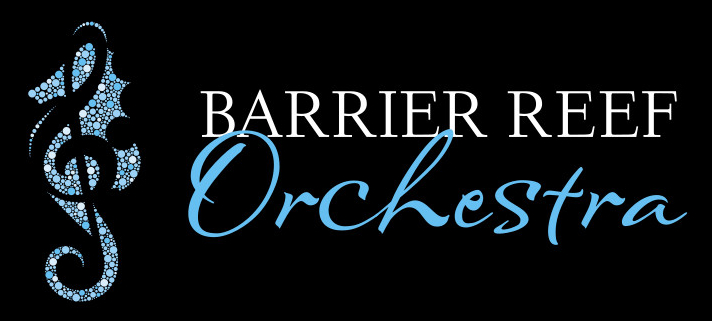Review: Music from Stage & Screen on 27th October 2018
by Billie Saint Rang
The last 2018 concert from the Barrier Reef Orchestra (with friends) was a sensation. Our musicians shone in their collaboration with some notable supremoes from the Queensland Orchestra. The night attracted the young(er) turnout and they, along with the BRO’s loyal concert-goers, packed the newly refurbished Civic Theatre to 700. This was second only to the Queens Gardens outing (in league with Australian Festival of Chamber Music).
Any concert entitled “Music from Stage and Screen” will always gather a captive audience. Whether it be the inclusion of work by a classical Master in a movie score or a Bugs Bunny cartoon (Bugsy was a great music appreciation teacher) most music lovers will probably agree that if someone tells you classical music is nowadays dead, they clearly have not been to the movies in the past 50 years.
Conspicuous by his rhapsodic conducting style, Richard Davis, at times virtually dancing on his podium, fired the Orchestra into some musical masterpieces once (or twice) enjoyed on the screen but re-invigorated by the BRO and Friends’ renderings.
Mozart’s Overture to The Marriage of Figaro opened the concert. It is said to be the most played and familiar of Mozart’s works. History records that Mozart composed the Overture just a few hours before the opera’s premier: yet another highlight of his genius. As a curtain raiser it also raised our audience to enthusiasm. Movie buffs remember this in the opening credits to the brilliant 1980s American ensemble comedy Trading Places and in Amadeus, a fictionalised biography of Mozart.
With the Theme Music from Batman (1989) the Orchestra captured the sheer essence of this Danny Elfram Batman score; music on the dark side, sometimes chilling. This 1989 movie had the best Joker ever (Jack Nicholson … “Ever dance with the devil in the pale moonlight?”) and the best Batmobile.
The three melodies from Greig’s Peer Gynt Suite No.1 drew resounding applause. The Morning tune is known to many for its inclusion in such TV series as The Big Bang Theory, The Simpsons, Father Ted, and Red Dwarf (or they know it from Bugs Bunny). In the Hall of the Mountain King, one of the most recognisable pieces of all time, is said to have made its screen debut in a 1930s film when the character portrayed by Perter Lorre whistled it whenever he was overcome by the urge to commit a murder. Recently it was used in the movie Johnny English, a James Bond spoof with Rowan Atkinson. The piece started quietly on cellos, basses and bassoon (ah, that bassoon!) and became louder and frenetic played on the other instruments and it built like Bolero (if Bolero had a sense of humour). The characterisations in the Peer Gynt Suite were given a clarity by the Orchestra’s presentation which shows that you don’t have to know Peer, the character, to understand the pieces. They work for Bugs Bunny or whoever claims the story.
Samuel Barber’s Adagio for Strings has been used to announce the deaths of famous politicians as well as highlighting some of the saddest aspects in film of the last five decades. The most notable of these were scenes in The Elephant Man and Lorenzo’s Oil. It was also used to great effect in the 1986 (anti) war movie, Platoon. Despite the suggestion in the program notes of this being “the saddest music in the world”, it is a favourite piece and the crowd loved it.
Another concert favourite on the program was Tchaikovsky’s Suite from Swan Lake. It contains some of Tchaikovsky’s most loved music. This ballet has been performed by almost every ballet company in the world. Most of us have seen it in one form or another; from Russia’s Bolshoi Ballet Company to Peppa Pig. The story of Odette turned into a swan has undergone many transformations, but the music remains recognizable and under the baton of Richard Davis, the Orchestra gave a vibrant performance.
The American composer John Williams gets more airplay on Classic FM than any of his contemporaries, so it was not a surprise that he had significant representation on the program with a five-item line-up. His E.T. Adventures on Earth, Flying Theme is based on music cues from the film. The music is heard as ET and Eliot flee from the authorities, culminating in the famous moment where the bicycle leaves the ground then and flies under ET’s power (and who didn’t let a bit of emotion kick in here?) The Superman March is recognized as an American all things spectacular. You might even believe a man can fly. John Williams has a knack for spotting the essence of a character and with Princess Leia’s Theme from The Star Wars Suite he managed to reveal the character’s complexity beginning with a gentle melody played on French horn with reserve and warmth. In the rest of the theme the complete Orchestra got it right; a bit of romance but some enigma. This perfectly epitomises the Princess Leia character. (Ms Fisher, May the Force Be with You.) The Imperial March Darth Vader’s Theme, perhaps the best villain theme ever. Feel the Power of the Dark Side! The Force is strong in John Williams. Who else could write a theme for the top villain who is liked more than the main character? This great piece of Hollywood music played with style and oomph brought the audience off their seats —- and the musicians looked pleased with their lot too.
The Orchestra’s performance was sensational. It’s level of sophistication now attracts the best visiting musicians as well as conductors of international calibre. Congratulations BRO musicians and management. (Oh, and the ties are still looking good.)
